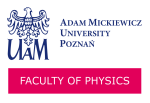Badanie nanodrutów o wielowarstwowej budowie po kątem wykorzystania ich w spintronicznych układach logicznych. Prezentacja wyników na międzynarodowych konferencjach naukowych (MoodMag)

Projekt MEiN/2022/DIR/3203 realizowany w ramach Programu Operacyjnego Wiedza Edukacja Rozwój 2014-2020 – Oś III Szkolnictwo Wyższe dla gospodarki i rozwoju – projekt pozakonkursowy o charakterze koncepcyjnym pt. „Najlepsi z najlepszych! 4.0”
Okres realizacji: 1.09.2022 – 30.06.2023
Zespół projektowy:
Hanna Reshetniak, studentka II roku Fizyki, specjalność PAMEP (email: hanres@st.amu.edu.pl )
Uladislau Makartsou, student II roku Fizyki, specjalność PAMEP (email: ulamak@st.amu.edu.pl )
Nikodem Leśniewski, student II roku Fizyki (email: nikles@st.amu.edu.pl )
Prof. Maciej Krawczyk, opiekun projektu (email: krawczyk@amu.edu.pl)
Zadania:
Zadanie 1: Udział w konferencji międzynarodowej z prezentacją wyników badań:
International Conference IEEE Advances in Magnetics AIM2023, Moena, Italy, Styczeń 2023
Zadanie 2: Udział w Konferencji międzynarodowej z prezentacją wyników badań:
Intermag Conference, Sendai, Japan, 2023, Maj 2023
Realizacja:
Zadanie 1:
Prezentacja ustna pt. „Ferromagnetic resonance in single and multi-layered crescent-shaped ferromagnetic nanorod” wygłoszona przez H. Reshetniak na konferencji IEEE Advances in Magnetics AIM2023, Moena, Italy w dniu 17 stycznia 2023 roku.
Zadanie 2
Prezentacja posterowa pt. Spin-wave dynamics in the multi-layered ferromagnetic crescent-shaped nanorod, Uladzislau Makartsou, Hanna Reshetniak, Nikodem Leśniewski, Mateusz Gołębiewski, zaprezentpwana przez U. Makartsou na konferencji Interma 2023, odbywającej się w Sendaj w Japonii w dniach 15-19.05.2023 I zgłoszona do konkursu na najlepszy poster.
Prezentacja ustna pt. Control of magnetization chirality in a ferromagnetic ring using a single nanoelement, wygłoszona przez U. Makartsou na konferencji Interma 2023, odbywającej się w Sendaj w Japonii w dniach 15-19.05.2023 I zgłoszona do konkursu na najlepszy prezentację ustną.
Publikacje:
M. Gołębiewski, H. Reshetniak, U. Makartsou, M. Krawczyk, A. van den Berg, S. Ladak, and A. Barman,
Spin-Wave Spectral Analysis in Crescent-Shaped Ferromagnetic Nanorods,
Phys. Rev. Appl. 19, 064045 (2023); DOI: 10.1103/PhysRevApplied.19.064045
http://dx.doi.org/10.1103/PhysRevApplied.19.064045
The research on the properties of spin waves (SWs) in three-dimensional nanosystems is an innovative idea in the field of magnonics. Mastering and understanding the nature of magnetization dynamics and binding of SWs at surfaces, edges, and in-volume parts of three-dimensional magnetic systems enables the discovery of alternative phenomena and suggests other possibilities for their use in magnonic and spintronic devices. In this work, we use numerical methods to study the effect of geometry and external magnetic field manipulations on the localization and dynamics of SWs in crescent-shaped (CS) waveguides. It is shown that changing the magnetic field direction in these waveguides breaks the symmetry and affects the localization of eigenmodes with respect to the static demagnetizing field. This, in turn, has a direct effect on their frequency. Furthermore, CS structures are found to be characterized by significant saturation at certain field orientations, resulting in a cylindrical magnetization distribution. Thus, we present chirality-based nonreciprocal dispersion relations for high-frequency SWs, which can be controlled by the field direction (shape symmetry) and its amplitude (saturation).

